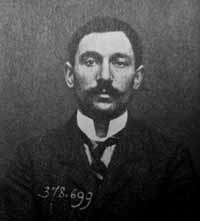- Vincenzo Peruggia
Infobox Person

caption = A police photograph of Vincenzo Peruggia in 1911.
birth_date = birth date|1881|10|8|
birth_place =Dumenza ,Italy
death_date = 1925
death_place =Haute-Savoie ,France
other_names =
known_for = theft of theMona Lisa
occupation =
nationality = ItalianVincenzo Peruggia (
October 8 ,1881 ,Dumenza ,Italy - 1925,Haute-Savoie ,France ) is the man who once stole the "Mona Lisa ".Theft
In 1911 Vincenzo Peruggia perpetrated what has been described as the greatest
art theft of the 20th century. The formerLouvre worker walked into the museum one day and, noticing the room containing the "Mona Lisa" had no guards or visitors, took the painting off its pegs, removed it from the frame, and walked out of the Louvre with it under his arm.Cite web
url=http://www.time.com/time/2007/crimes/2.html
title=STEALING THE MONA LISA, 1911
work=The Top 25 Crimes of the Century
last=Chua-Eoan
first=Howard
publisher=Time Magazine
accessdate=2007-08-15]Vincenzo hid the painting in his apartment in Paris. Supposedly, when police arrived to search his apartment and question him, they signed documents on top of the painting, which was hidden under the kitchen tablecloth.
After keeping the painting hidden in a trunk in his apartment for two years, Peruggia returned to Italy with it. He kept it in his apartment in
Florence but grew impatient and was finally caught when he contacted a friend of his who sold copies of it. He wanted to donate it to theUffizi Gallery in Florence and use his friend as intermediary but his friend, seeing a money-making opportunity or even a possible huge reward, attempted to sell it to the directors of the museum. After confirming authenticity, the directors turned Peruggia over to the authorities.After its recovery, the painting was exhibited all over Italy with banner headlines rejoicing its return and then returned to the Louvre in 1914.
Motivations
No definitive motive exists,Fact|date=August 2007 however there are currently two theories.
Peruggia said he did it for a patriotic reason: he wanted to bring the painting back for display in
Italy after it was stolen byNapoleon . Although perhaps sincere in his motive, Vincenzo may not have known thatLeonardo da Vinci took this painting as a gift forFrancis I when he moved toFrance to become a painter in his court.Some Fact|date=August 2008 have also questioned the "patriotism" motive on the grounds that -- were patriotism the true motive -- Peruggia would have donated the painting to an Italian museum, rather than attempt to profit from its sale. However it is believed that the "friend" was the one who attempted to profit from the sale since Peruggia never divulged its secret for nearly two years.
Put on trial, the court agreed to some extent that Peruggia committed his crime for patriotic reasons and gave him a lenient sentence. He was sent to jail for one year and fifteen days, but was hailed as a great patriot in Italy and served only a few months in jail.
Another theory emerged later. The theft may have been encouraged or master-minded by
Eduardo de Valfierno , a con-man who had commissioned the French art forgerYves Chaudron to make copies of the painting so he could sell them as the missing original. The copies would have gone up in value if the original was stolen.References
Wikimedia Foundation. 2010.
